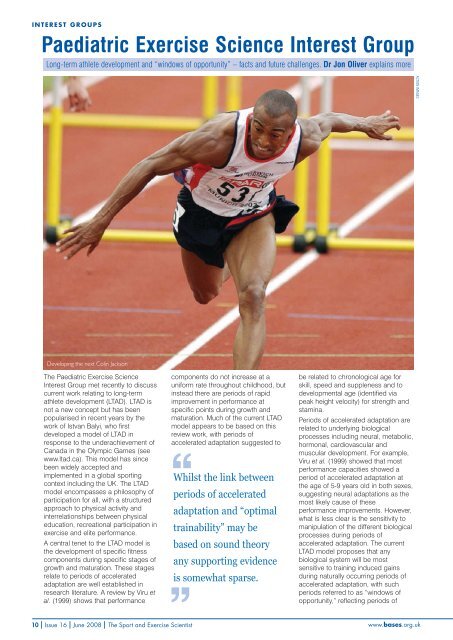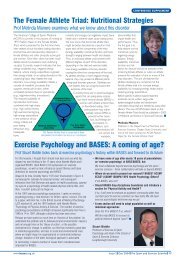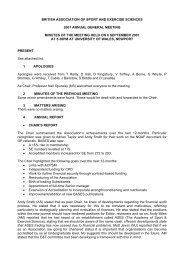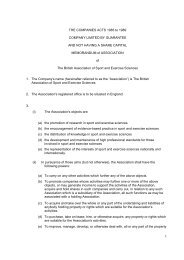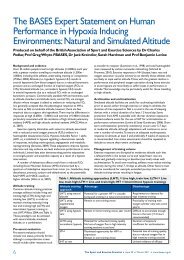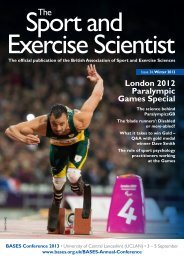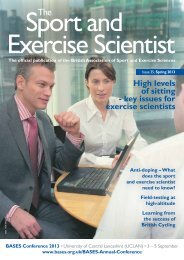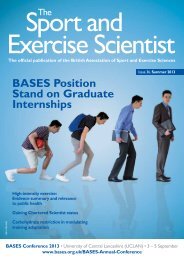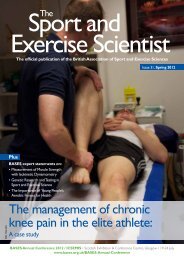ACTION IMAGESINTEREST GROUPSPaediatric Exercise Science Interest GroupLong-term athlete development and “windows of opportunity” – facts and future challenges. Dr Jon Oliver explains moreDeveloping the next Colin JacksonThe Paediatric Exercise ScienceInterest Group met recently to discusscurrent work relating to long-termathlete development (LTAD). LTAD isnot a new concept but has beenpopularised in recent years by thework of Istvan Balyi, who firstdeveloped a model of LTAD inresponse to the underachievement ofCanada in the Olympic Games (seewww.ltad.ca). This model has sincebeen widely accepted andimplemented in a global sportingcontext including the UK. The LTADmodel encompasses a philosophy ofparticipation for all, with a structuredapproach to physical activity andinterrelationships between physicaleducation, recreational participation inexercise and elite performance.A central tenet to the LTAD model isthe development of specific fitnesscomponents during specific stages ofgrowth and maturation. These stagesrelate to periods of acceleratedadaptation are well established inresearch literature. A review by Viru etal. (1999) shows that performancecomponents do not increase at auniform rate throughout childhood, butinstead there are periods of rapidimprovement in performance atspecific points during growth andmaturation. Much of the current LTADmodel appears to be based on thisreview work, with periods ofaccelerated adaptation suggested to‘‘Whilst the link betweenperiods of acceleratedadaptation and “optimaltrainability” may bebased on sound theoryany supporting evidenceis somewhat sparse.‘‘be related to chronological age forskill, speed and suppleness and todevelopmental age (identified viapeak height velocity) for strength andstamina.Periods of accelerated adaptation arerelated to underlying biologicalprocesses including neural, metabolic,hormonal, cardiovascular andmuscular development. For example,Viru et al. (1999) showed that mostperformance capacities showed aperiod of accelerated adaptation atthe age of 5-9 years old in both sexes,suggesting neural adaptations as themost likely cause of theseperformance improvements. However,what is less clear is the sensitivity tomanipulation of the different biologicalprocesses during periods ofaccelerated adaptation. The currentLTAD model proposes that anybiological system will be mostsensitive to training induced gainsduring naturally occurring periods ofaccelerated adaptation, with suchperiods referred to as “windows ofopportunity,” reflecting periods of10 l Issue 16 l June 2008 l The Sport and Exercise Scientistwww.bases.org.uk
“optimal trainability.” Failure tomaximise athletic development duringthese “windows of opportunity” limitspossibilities of reaching sportingpotential in later life.Whilst the link between periods ofaccelerated adaptation and “optimaltrainability” may be based on soundtheory any supporting evidence issomewhat sparse. Few people wouldargue against greater musculardevelopment when training iscombined with increased levels ofcirculating testosterone. Consequently,a maturity related “window ofopportunity” for the development ofstrength during adolescence seems alogical assumption. Whether all theassumptions of the current LTAD arevalid is yet to be demonstrated. Thedevelopment and trainability of aerobicfitness throughout childhood hasprobably received more attention thanany other fitness component. Baquetet al.’s (2003) review foundunconvincing evidence for a period ofoptimal trainability of endurance duringadolescence, with similar traininggains in aerobic fitness in youngchildren and adolescents.Some coaches are sceptical about theintroduction of LTAD, particularly themovement towards decreasedcompetition and increased trainingloads in young athletes, raisingconcerns over the failure of the currentapproach to lead to success at asenior level. These comments havebeen underpinned by the observationthat adopting the LTAD process isproducing extremely fit individuals, butthese players have insufficient skillsand competitive experience. Whilstsome coaches would argue for areturn to greater competitive loads inyoungsters, it is possible that the LTADphilosophy is correct but itsimplementation is less than optimal.Currently there is a substantialemphasis on fitness development,particularly around the adolescentyears, which may be at the expense ofother important factors (e.g., skill).The current challenge is to develop abetter understanding of the linkbetween growth, maturation, trainingand competition. This is a difficult taskwith the interaction of so manyvariables, however, this does not meanit is a task that should be avoided.Within the Interest Group, there are anumber of studies going on, whichinclude dual purpose applied/researchwork with a number of team andindividual sports, as well asexamination of the development ofless well understood parametersduring childhood (such as thedevelopment of explosive power).Welsh Athletics are currently in theprocess of setting up a longitudinaltalent development programme, whichwill look to recruit more youngstersinto the sport of athletics and providethem with specialist coaching at threenational centres. Coaching will focuson the development of generic athleticskills rather than attaching anyindividual to a single event. UWIC willhopefully support this programme bytracking the performance of athleteswho enter into this programme andthose who stay in athletics beyond theprogramme. We will also be aiming todevelop the research opportunitieswithin the programme by makingcomparisons with control groups andexamining responses to specifictraining interventions. We should beable to identify the magnitude oftraining and growth induced gains inperformance, as well as establishingthe rate of continued improvementrequired to succeed at a senior level(and the likelihood of this occurring).This accumulation of data shouldprovide benchmarks for performancestandards that need to be achieved bycertain stages of development to allowfor future competitive success.Importantly we will also be able tobegin to examine the sensitivity totraining at different stages of growthand maturation.A systematic and evidence-basedapproach is required to try to get closeto understanding the process of LTAD.Such an approach requiresconsiderable cooperation andenthusiasm from sports associationsand national governing bodies, whichhopefully will be generated by the2012 Olympic Games. Unfortunately,much of this work will start too late tohave an impact on performance duringthe 2012 Games, but it could helpsecure a bright long-term future forBritish sports. ReferencesBaquet, G., Van Praagh, E. & Bertoin, S.(2003). Endurance training and aerobic fitness in youngpeople. Sports Medicine, 33, 1127-4113.Canadian Sport Centres (2008). Long-term athletedevelopment. http://www.ltad.caViru, A., Loko, J., Harro, M. et al. (1999). Criticalperiods during the development of performance capacityduring childhood and adolescence. Physical Education andSport Pedagogy, 4, 75-119.Dr Jon OliverJon is a Lecturer in ExercisePhysiology at the University ofWales Institute, Cardiff(joliver@uwic.ac.uk) INTEREST GROUPSwww.bases.org.ukIssue 16 l June 2008 l The Sport and Exercise Scientist l 11


